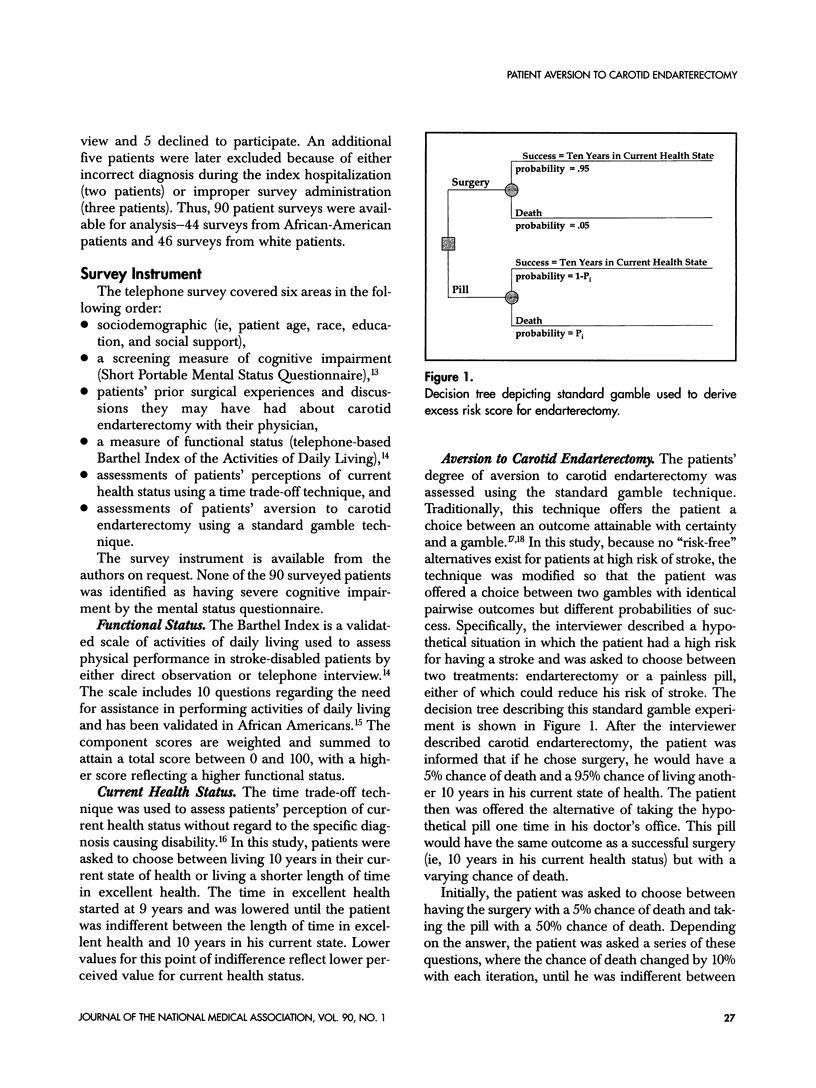Abstract
Previous studies indicate that African-American patients undergo carotid endarterectomy at one fourth the rate of white patients. This study was undertaken to determine if differences in aversion to carotid endarterectomy might account for some of the racial difference in utilization of this procedure. A sample of 185 African-American and white patients was selected from a cohort of patients hospitalized for stroke or transient ischemic attack at four Veterans Affairs medical centers. Of these patients, 115 (62%) were able to be contacted by telephone and 95 (83%) agreed to be interviewed. The interview included assessments of functional status, patient preferences for their current health status, and risk aversion to a hypothetical carotid endarterectomy. Patients from both racial groups were similar in age, marital status, level of education, and comorbid medical illnesses. All respondents were male. Functional status for both groups was high and not statistically different. There were no significant racial differences in patients' perceptions of their current health state. However, African-American patients expressed more aversion to the hypothetical surgery than whites. The median excess risk of death accepted to avoid surgery was 20% for African Americans versus 2.5% for whites. These results indicate that racial differences in the utilization of carotid endarterectomy may be due in part to differences in patients' levels of aversion to this surgery.
Full text
PDF








Selected References
These references are in PubMed. This may not be the complete list of references from this article.
- Caplan L. R. Strokes in African-Americans. Circulation. 1991 Apr;83(4):1469–1471. doi: 10.1161/01.cir.83.4.1469. [DOI] [PubMed] [Google Scholar]
- Charlson M. E., Pompei P., Ales K. L., MacKenzie C. R. A new method of classifying prognostic comorbidity in longitudinal studies: development and validation. J Chronic Dis. 1987;40(5):373–383. doi: 10.1016/0021-9681(87)90171-8. [DOI] [PubMed] [Google Scholar]
- Froberg D. G., Kane R. L. Methodology for measuring health-state preferences--I: Measurement strategies. J Clin Epidemiol. 1989;42(4):345–354. doi: 10.1016/0895-4356(89)90039-5. [DOI] [PubMed] [Google Scholar]
- Gafni A. The standard gamble method: what is being measured and how it is interpreted. Health Serv Res. 1994 Jun;29(2):207–224. [PMC free article] [PubMed] [Google Scholar]
- Ghali J. K., Cooper R. S., Kowatly I., Liao Y. Delay between onset of chest pain and arrival to the coronary care unit among minority and disadvantaged patients. J Natl Med Assoc. 1993 Mar;85(3):180–184. [PMC free article] [PubMed] [Google Scholar]
- Gil-Peralta A., Alter M., Lai S. M., Friday G., Otero A., Katz M., Comerota A. J. Duplex Doppler and spectral flow analysis of racial differences in cerebrovascular atherosclerosis. Stroke. 1990 May;21(5):740–744. doi: 10.1161/01.str.21.5.740. [DOI] [PubMed] [Google Scholar]
- Heyman A., Karp H. R., Heyden S., Bartel A., Cassel J. C., Tyroler H. A., Cornoni J., Hames C. G., Stuart W. Cerebrovascular disease in the bi-racial population of Evans County, Georgia. Stroke. 1971 Nov-Dec;2(6):509–518. doi: 10.1161/01.str.2.6.509. [DOI] [PubMed] [Google Scholar]
- Horner R. D., Matchar D. B., Divine G. W., Feussner J. R. Racial variations in ischemic stroke-related physical and functional impairments. Stroke. 1991 Dec;22(12):1497–1501. doi: 10.1161/01.str.22.12.1497. [DOI] [PubMed] [Google Scholar]
- Horner R. D., Oddone E. Z., Matchar D. B. Theories explaining racial differences in the utilization of diagnostic and therapeutic procedures for cerebrovascular disease. Milbank Q. 1995;73(3):443–462. [PubMed] [Google Scholar]
- Kuhlemeier K. V., Stiens S. A. Racial disparities in severity of cerebrovascular events. Stroke. 1994 Nov;25(11):2126–2131. doi: 10.1161/01.str.25.11.2126. [DOI] [PubMed] [Google Scholar]
- Maxwell J. G., Rutherford E. J., Covington D., Clancy T. V., Tackett A. D., Robinson N., Johnson G., Jr Infrequency of blacks among patients having carotid endarterectomy. Stroke. 1989 Jan;20(1):22–26. doi: 10.1161/01.str.20.1.22. [DOI] [PubMed] [Google Scholar]
- Mayberg M. R., Wilson S. E., Yatsu F., Weiss D. G., Messina L., Hershey L. A., Colling C., Eskridge J., Deykin D., Winn H. R. Carotid endarterectomy and prevention of cerebral ischemia in symptomatic carotid stenosis. Veterans Affairs Cooperative Studies Program 309 Trialist Group. JAMA. 1991 Dec 18;266(23):3289–3294. [PubMed] [Google Scholar]
- Maynard C., Fisher L. D., Passamani E. R., Pullum T. Blacks in the coronary artery surgery study (CASS): race and clinical decision making. Am J Public Health. 1986 Dec;76(12):1446–1448. doi: 10.2105/ajph.76.12.1446. [DOI] [PMC free article] [PubMed] [Google Scholar]
- Nease R. F., Jr, Kneeland T., O'Connor G. T., Sumner W., Lumpkins C., Shaw L., Pryor D., Sox H. C. Variation in patient utilities for outcomes of the management of chronic stable angina. Implications for clinical practice guidelines. Ischemic Heart Disease Patient Outcomes Research Team. JAMA. 1995 Apr 19;273(15):1185–1190. [PubMed] [Google Scholar]
- Oddone E. Z., Horner R. D., Monger M. E., Matchar D. B. Racial variations in the rates of carotid angiography and endarterectomy in patients with stroke and transient ischemic attack. Arch Intern Med. 1993 Dec 27;153(24):2781–2786. [PubMed] [Google Scholar]
- Pfeiffer E. A short portable mental status questionnaire for the assessment of organic brain deficit in elderly patients. J Am Geriatr Soc. 1975 Oct;23(10):433–441. doi: 10.1111/j.1532-5415.1975.tb00927.x. [DOI] [PubMed] [Google Scholar]
- Shinar D., Gross C. R., Bronstein K. S., Licata-Gehr E. E., Eden D. T., Cabrera A. R., Fishman I. G., Roth A. A., Barwick J. A., Kunitz S. C. Reliability of the activities of daily living scale and its use in telephone interview. Arch Phys Med Rehabil. 1987 Oct;68(10):723–728. [PubMed] [Google Scholar]
- Torrance G. W. Measurement of health state utilities for economic appraisal. J Health Econ. 1986 Mar;5(1):1–30. doi: 10.1016/0167-6296(86)90020-2. [DOI] [PubMed] [Google Scholar]


